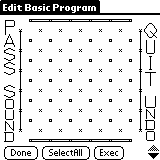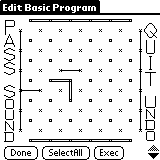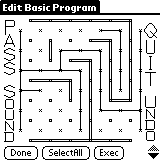Dots 1.2
Dots is a two-player strategy game. The board starts out looking like this:

There are many small Xs and Os (these are the "dots"). The Xs are Player One's dots, and the Os are Player Two's. Player One wants to connect any of the Xs at the far left (which start all connected to each other) to any of the Xs at the far right. Meanwhile, Player Two is trying to connect any of the Os at the top to any of the Os at the bottom.
Players take turns, making one segment at a time. Players may not cross their opponent's lines.
So, after each player has played two turns, the board might look like this:

And that's all there is to the game. There can never be a tie. All games will eventually lead to a winner. One possible end, where Player One has won, is shown here:

How to Use My cbasPad Implementation of Dots
If the sound is on, there is a beep indicating which player's turn it is; one beep for Player One, two beeps for Player Two. To make your move, merely tap in between the two dots you want to connect (note that you do NOT drag from one dot to the next -- just tap between them). If you tap in a spot where either you or your opponent has already drawn a segment, there is a low-pitched beep, followed by the player's beep again.
Tapping on the word "PASS" at the left hand side of the screen will skip the current player's turn, and will beep to indicate the other player's turn. Since it is unlikely that passing could be strategically advantageous at any time, this feature is really intended only to be used to allow Player Two to start the game if so desired, by having Player One pass on his/her first turn.
As a default, sound is turned on. Tapping the word "SOUND" toggles this setting.
Tapping on the word "QUIT" at the right hand side of the screen quits. Note that under the current version of cbasPad, if the program was run by hitting "SelectAll" and "Exec", the screen will still have the graphics. Tap "Done" and then "Edit" to return to the actual Basic code.
Tapping the word "UNDO" will undo the last move made, and will beep indicating the same player's turn again. I added this feature in version 1.2 because cbasPad had the new functionality of being able to erase lines, and I had found that people often tap in slightly the wrong place, which can be disastrous if they are forced to keep the unintended move. Tapping undo a second time does nothing (i.e. you cannot undo the undo, and you cannot undo more than one move).
When you run the program, it will take a moment to actually read the entire program into the interpreter. After it finishes reading the program, it clears the screen, draws the words "PASS", "SOUND", "QUIT", and "UNDO", and then it beeps once to indicate Player One's turn.
The program does not have any "AI" for playing against the computer. So you have to play with two players, or else play against yourself. (The AI for a computer player would probably not be doable in Basic. But someday I'd like to port Dots to waba, and play with implementing a computer-player to play against. Someday...)
Also, it doesn't recognize when a player has won. It's assumed that the user can see when the game is over, and will then tap "QUIT". Again, in Basic, it would be rather difficult to check for final positions...
How to Install It
First of all, you'll need cbasPad installed on your PalmPilot. (Okay, *first* you'll need a PalmPilot...) You can get it from here.
If you've installed cbasPad, you'll need to install Dots itself. Get the code from the link below, paste it into a new memo in your Palm Desktop software, and do a HotSync. Then on the handheld, go into cbasPad, select "Import" from the "Options" menu, and punch in "# dots" (without the quotes). This will display the code of Dots. Tap "Done" to go back to the program list, select dots and tap "Exec".
So here it is: dots12.bas.